The State of Swift Production: Interactivos?’08 (part 3 of 3), by Eduardo Navas
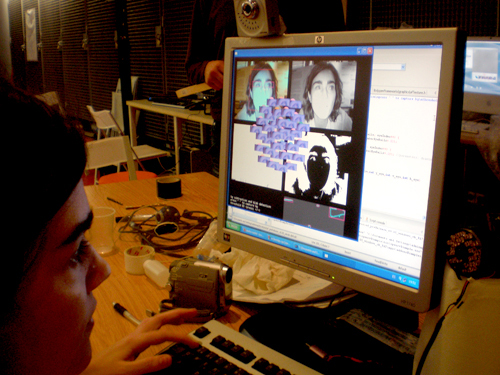
Image: Anaisa Franco, Testing software for “Expanded Eye”
See Part 1: https://remixtheory.net/?p=315
See Part 2: https://remixtheory.net/?p=319
Interactivos?’08-Madrid promoted Vision-play as a point of entry to reflect on how interactivity is redefining aesthetics in art particularly invested in emerging technologies. The Medialab-Prado website presented the two week work intensive series of events as a “workshop [that] aims to use open hardware and open code tools to create prototypes for exploring image technologies and mechanisms of perception.”[1]
To provide a rigorous contextual ground following this premise as a frame of reference for artists and collaborators, the Medialab organized a two day long conference in which artists presented their projects and scholars and writers presented papers focused on the ongoing changes of the image (vision-play) in contemporary art production. On the first day Marta Morales presented “Caída del juego: lo inaparente en la imagen” (Fall of the Game: The Inapparent in the Image), a text in which she explored the void of experience leaning towards the sublime in the work of Giacommeti; she examined his work from drawings to sculptures. I followed with “The Bond of Repetition and Representation,” in which I outlined previously introduced definitions of Remix and their links to the ongoing play between repetition and representation in digital media. Nadine Wanono then discussed her research on Visual Anthropology in “The Camera and The Perspective, as Tool and Metaphor.” In her talk she questioned the supposed objectivity of perspective, both formally and conceptually, when anthropologists study non-western cultures. Wanono’s presentation consisted of selected research she performed in Mali, West Africa, where she spent many years with the Dogon people. And the evening ended with Domingo Sarrey who presented “Cuadrats 40 años después” (Quadrats, 40 Years Later). Sarrey took the evening when he made many Spaniards in the audience aware about art and computer science explorations that took place in Madrid during the sixties. Sarrey was one of the first artists in Madrid to use the computer to develop drawings during that time period.

Image: From left to right, Nuria Valverde and Marta Morales
The second day of conferences featured four other texts. Ruth Sergel presented, “Alchemy of Light” in which she outlined the close relation of magic to film. Sergel argued that illusion which at the time of early film was invested in understanding the limitations of the corporeal, today is found as a trace in emerging fields within the preoccupation of constantly being connected to others; she argued that the current reality leads to a form of disembodiment, due to dependence on network communication. Carmen Gil Vrolijk presented “Demiurgos de la Luz, o de la caverna a la cultura VJ_proyecciones en tiempo real descanso,” (Demiurges of Light, or from the Cavern to VJ Culture_Projections in delayed realtime), in which she offered a concise history of VJ Culture, from the early days of the Camera Obscura on to Nam June Paik, ending with contemporary VJ Practice. José Ramón Marcaida presented “Visiones barrocas: conocimiento e ilusión,” (Baroque Visions: Knowledge and Illusion) in which he discussed how paintings since the enlightenment consisted of fragments presented as a seamless whole. And Manuel Sánchez-Gestido presented “The Visual Web: Where Semantics Meets” in which he shared the implications of the next stage of the Web. Sánchez-Gestido argued that what Tim Berners Lee foresaw in the nineties may be becoming a reality in the near future, but with other elements for great control. In this next stage Data Mining will be even more optimized.
These presentations were complemented with more lengthy lectures by Nuria Valverde who presented her text “Visual Machinations: Scientific Images, Systemic Parts and Imagination” in which she explored the conceptual layers of visualization. Valverde outlined the diverse illustrational forms of zooming into different parts of the body, which began to be developed in the 15th century, mainly through illustrations that showed the body in detailed parts, almost always next to a representation of the whole. She connected this visual methodology to modularity in digital practice today, explaining that we can think in terms of pieces quite easily because such thinking began in the early days of modern science. James Elkins lectured about non-narrative scientific film in “On Some Limits of Film Theory: Scientific and Technical Films.” He argued that film theorists have neglected to analyze scientific and technical films because such films, in part, don’t follow the expected parameters of narrative film. He explained that how the images of scientific films come to be developed, which for him is a simulation that is arbitrary and defined to make the information accessible, is worth considering in terms of film language following the theories of Deleuze and others. And finally, Susana Martínez Conde literally made the audience perform her presentation titled “Illusion and Illusionism: How to Fool the Brain with Magic and Other Tricks.” Conde put on a powepoint extravaganza in which the audience learned about the limits of visual perception. Conde demonstrated with various experiments how perception is in part limited and defined by how we pay attention to certain elements in our visual field.
Two more presentations were organized for Thursdays during the two weeks. The first was by Jose Luis Brea who discussed his theory of the e-image. He argued that the electronic image has recuperated (his term) the qualities of mental images; In a round about way, he referred to the apparent ephemerality and instability of digital images. Jimena Canales presented her reading of Deleuze and Bergson, revisiting their theories of film. She updated Deleuze’s critique of Bergson, explaining that according to Deleuze, Bergson could not have developed an advanced theory of film because during the time he lived, film was at an early stage of development.
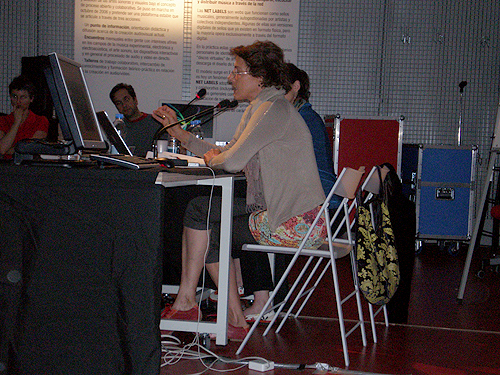
Image: Nadine Wanono, presenting “The Camera and The Perspective, as Tool and Metaphor”
The breadth and diversity of the texts left much to think about for the artists and collaborators who were to begin developing their projects as soon as the next day. At this point some questions on what Vision-play could mean became present. On my part, I kept in mind two particular elements that were pronounced in all of the works. First was the concept of movement: all works reacted to the movement of the gallery visitor, or some other element such as the Sun; and second, how the movement varied: whether or not it was triggered by the gallery visitor. With this in mind, looking back on the projects previously reviewed in parts 1 and 2 of this text series, we can notice how sensors were vital to many of the projects.
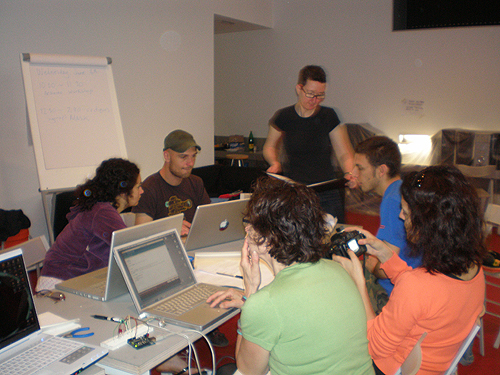
Image: Collaborators working on Nova Jiang’s project “Stage Fright”
“Stage Fright” by Nova Jiang uses a sensor to move the projected video back and forth, matching the swinging of the gallery visitor. “Immodesty” by Karolina Sobenka also uses a sensor to move the stop motion sequence back and forth according to the horizontal movement of the gallery visitor. “Expanded Eye” by Anaisa Franco uses a movement sensor as well, to keep track of the times the viewer blinked, to then multiply the projected eye. “360 Score” by Philippe Chatelain also uses a sensor to detect where the visitor stands in relation to the drawing, to then produce an abstract sound; and in similar fashion “Biophionitos” by Paola Guimerans, Horacio González, and Igor González detects the position of the viewer to trigger the speed of a Zoetrope wheel inside a wooden box. “M.A.S.K. (My Alter Self Konsciousness)” by Jordi Puig also takes into account the presence of the viewer. In this case, however, the visitor sits down and looks at herself in the mirror. Shortly after, a mask-like shape appears around the eyes. This shape elegantly shifts form and also follows the user’s profile within the mirror’s frame.

Image: Esther Polak with collaborator working on her project “Spiral Drawing”
“Bloop” by Martin Nadal also demands user interactivity, but very much following the functionality found in software application programs such as Photoshop. Here, the user can choose a frame from a video sequence and draw on it as desired. When done, the changes to the file are saved, and the user can view the actual video sequence which then includes the modified still. “Spiral Drawing” by Esther Polak also uses sensors. Unlike the other projects, however, Polak’s work is optimized to sense sunlight, in order to create drawings in form of a spiral. Polak places paper on the floor so that the sand dropped by the robot can be used to create a drawing from the residue.
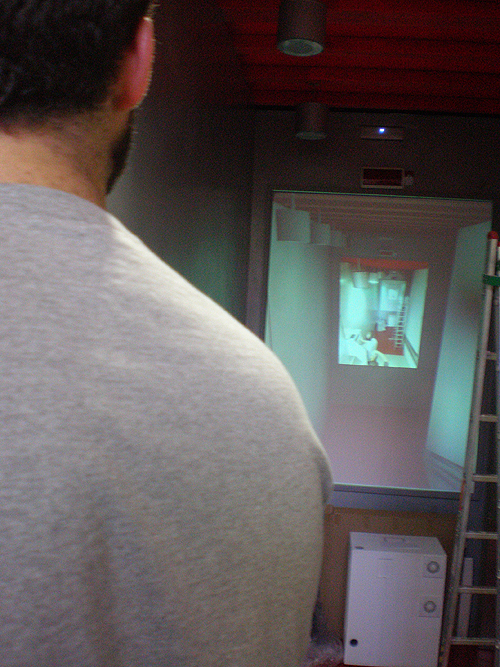
Image: Walter Langelaar testing his installation at the entrance of the Medialab
One of the few projects that did not use a sensor was “augment(0)scope” by Eloi Maduel. The project consists of a wooden box, reminiscent of early optical boxes from the 18th century used to take viewers on what today would be equivalent of a virtual journey through various landscapes. In Maduel’s project, the user can navigate through a spiral-like photo-collage composition by manipulating back and forth two handles placed on the sides of the optical box. The images used are documentation of polluted environments throughout the world. Finally Daedalus_ex_Machina [DexM] by Walter Langelaar is a projection that includes viewers in every other reproduction of a pattern based on the principles of the Recursive Descent Parser. In this last project users do not trigger anything, but simply acknowledge their own presence within the virtual world.

Image: A full day at work at the Medialab
What is woth noting here is that all the projects, except for Polak’s Spiral, were designed to include the viewer in the completion of the work, by offering feedback of some sort. Thus, one can ask, does the notion of “play” in visual language today necessarily have to mean some sort of movement or feedback that the user must come to terms with? Why this obsession with constantly triggering the work of art to move, often as an acknowledgment of the user’s presence? Can Vision-play mean anything else when using digital technology to develop works of art?
Throughout the two weeks of my stay in Madrid, I was able to visit three of the most famous museums that the city hosts, The Prado Museum, The Reyna Sophia and the Thyssen-Bornemisza Museum. As I moved through the large galleries of these museums, I noticed in just about all the works, that movement was a constant interest. All works, whether sculptures, paintings or even installations dealt with the preoccupation of moving through space. From Joan Miró’s paintings to Robert Smithson’s lecture on a Hotel Palenque located in the Peninsula of Yucatan, which consists of a slide lecture that Smithson later gave to students in the School of Architecture at the University of Utah, movement played a key role. At the Reyna Sophia, Guernica was the ultimate statement of movement within the language of painting. When in front of the painting, one is unable to take it all in at once. Instead, fragments slip into view. This fragmented reality becomes a metaphor for Picasso’s critical position against the violence of war. The viewer must move across the painting to take it in pieces. From a distance, it feels too detached, and one longs to approach it, yet again. This constant back and forth, in a way reminded me of the preoccupations of movement present in the works at the Medialab: that back and forth found particularly in the works of Jiang’s and Sobenka’s video installations.

Image: Collaborators hacking digital cameras for Karolina Sobenka’s project “Immodesty”
After viewing modern art at the three museums, I came to the conclusion that in current art practice we have the ability to not only create artworks that literally move but which also overtly include the viewer as part of the work, either as the person who triggers it, or as an active participant. This may in the end be a narcissistic gesture, which comes to be embraced by the viewer, and which, one could say is becoming an obsession for artists to develop new media work. One must wonder if this tendency will soon turn into a nice trick that must be superseded for more rigorous content development.
One thing that most of the projects share is that the devices and installations developed could contain diverse content; and one of the struggles that artists and collaborators found the most difficult was to develop and decide what content to include in their installations. They knew how to develop intricate forms, combining electronics, computer software and wood, but the content that came to be presented through these forms was for many unknown until well into the second week, if not the day before the exhibition.
Jiang for example collaborated with video artists who shot lots of footage, from which they later chose a sequence of about 3 or 4 segments. In her work, one can notice the potential for an installation invested in criticality. This possibility becomes most obvious when an Afro-Colombian man, Oswald Aspilla Pérez, one of Jiang’s collaborators, swings upside down as the gallery visitor also rides on the swing. Given the codes of blackness still prevalent throughout countries affected by colonization, one can see how moving in this direction would turn stage fright into a metaphor for different kinds of fears some based on cultural conflicts: the place of afro-culture beyond the sub-altern here could appear with the possibility to be questioned for the struggles it still encounters globally. However, this possibility does not come about in Jiang’s project; and it falls short, as the rest of the images are rather safe–one could even say soothing to the eye. The most obvious was a clip showing dusk till dawn in a city. Nevertheless, the potential is there, because all the artist has to do is think critically about the kind of footage to include.
Sobenka was quite aware of this issue of content, as she proposed during her presentation, before beginning production, that she would like collaborators to think of the project as a platform that could be used by anyone. Therefore, the camera rig that she created to enact the gun shot effect reminiscent of the Matrix, becomes an open platform. Her attempt to show the openness of her project led her to show footage of her collaborators working on an open field; therefore, showing the process itself, not necessarily aiming to take a critical position. Like Jiang’s work, the viewer finds herself craving stronger content. This symptom was at play with most of the other works, and due to space I will not go over them here, but upon reviewing the previous two texts this sensibility becomes evident.
Does art need to be critical? may be a question that arises here in some readers. This question can only be answered in part on a personal level, but it goes without saying that since the early days of modernism criticism has been a vital ingredient to create works of art. New Media works should be held to the same standards, as well.
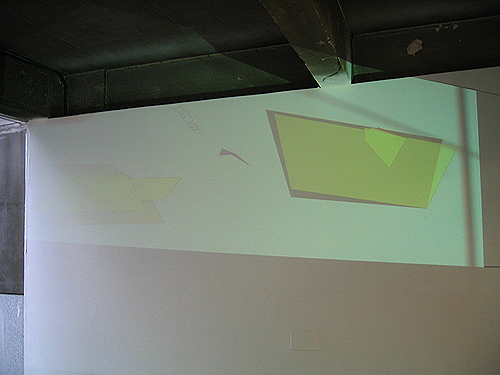
Image: “What’s the name of it” by Colette Laliberte and Simone Jones, installation detail
A hint of the preoccupation with criticism mentioned above did manifest itself at the very entrance of the Medialab, with a subversive installation created by one of the instructors, Simone Jones and a collaborator, Colette Laliberte. They created a simple animated projection of geometrical shapes that strategically redefined the upper left entrance wall of the Medialab. The projection could be missed if one did not look carefully, but upon recognizing it, one realized that some of the shapes moved in and out of the frame with an apparent aim to link 2-D and 3-D space. This was further accentuated with the placement of thin strips of black tape that extended the frame of the projection on to the windows of the administrative offices of the Medialab. And in this way, the visitor who would normally miss the existence of the administration, became aware of the less magical activities that are necessary for the lab’s production. Their project was extremely formal, no social commentary was apparent, yet the title echoed the question that viewers who would walk out of the Medialab’s main space would ask: “What’s the name of it?”
Now, one thing that makes all of the works presented at Interactivos?’08 different is the fact that the artists consider them “prototypes.” Indeed, this is actually explained in the description of the process that I quoted at the beginning of this text. This means that the greatest potential of all of the works developed in Interactivos?’08 is in that they can keep on being improved, and in this sense the art critic must be open to consider the projects similar to software that can be improved in later versions according to user feedback. It is no coincidence that artists often refer to their new media works metaphorically in terms of software applications: 1.0, 1.5, 2.0 etc.
With this reality, then I admit that my critical position on the actual content delivered by the works is not final, nor dismissive, but rather optimistic, as I hope that the artists and collaborators will be more than willing to keep refining the works as these are shown in different places. I think the artists and collaborators of Interactivos?’08 may be open to this approach because of the way the two week workshop started: with a series of text presentations that provided a wide frame of reference for ongoing development; many of the texts often came up during discussions throughout the two weeks.
Interactivos?’08, in this sense, appears invested in emerging fields always open to critical discourse: they provide the means, and at no point do they put pressure on anyone during the creative process. It is now up to the individuals who participated, then, to come to terms with what the next stage in their production will be. Interactivos?’08 is now also taking place in Lima, Mexico City and New York. One must wonder of how these upcoming workshops will be different from Medilab-Prado’s.
[1] Medialab-Prado <http://medialab-prado.es/article/interactivos08_vision_play#theme>
Medialab Prado’s Main site: http://medialab-prado.es/
Interactivos? main website: http://www.interactivos.org/
List of projects with proper descriptions: http://medialab-prado.es/article/interactivos08_-_juegos_de_la
_vision_lista_de_comunicaciones_y_proyectos_seleccionados
Medialab Flickr: http://www.flickr.com/photos/medialab-prado/
Medialab Wiki: http://wiki.medialab-prado.es/index.php/Main_Page
Other lines of work, year round:
Visualizar: http://medialab-prado.es/visualizar
Inclusiva: http://medialab-prado.es/inclusiva-net
Commons Lab: http://medialab-prado.es/laboratorio_del_procomun
AVLAB: http://medialab-prado.es/avlab2
Lascia un commento
You must be logged in to post a comment.








